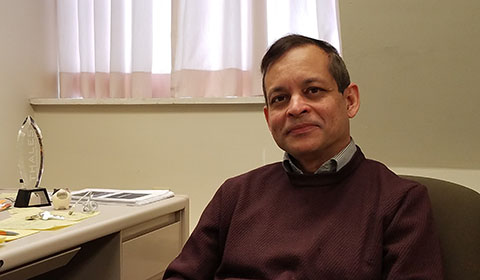By Rachael Beardsley
NQPI Editorial Intern
Nanoscale and Quantum Phenomena Institute 2020 Spring Newsletter
The Nanoscale and Quantum Phenomena Institute’s newest member, Dr. Faiz Rahman, discovered his interest in electrical engineering early in his physics career. Now, his research blends the two disciplines with a focus on electronics and photonics.
Rahman received a bachelor’s degree in physics as well as a master’s degree in semiconductor science and technology. By the time he was working on his doctorate, Rahman had transitioned to electrical engineering, though still with a focus on physics research.
“Semiconductor science is the area where physics and electrical engineering meet,” Rahman said. “So, people who are working in this field can claim to be either physicists or electrical engineers and be accepted as either.”
Research on the interaction between light and matter, for instance, allows him to identify mechanisms to enhance the emission of light in devices. One example is Rahman’s research on photonic crystal LEDs, where LED devices are made brighter by making nanometer sized holes on the surface of the material.
“Unlike in a laser, light is emitted in all directions inside an LED and some that are traveling horizontally gets trapped inside the crystal that the LEDs are made from, failing to exit the device vertically,” Rahman said. “So what the holes do is act as a diffraction grating that change the direction of the light from horizontal to vertical so it can come out. That’s how the LED becomes brighter. The physics is somewhat more subtle than the holes simply allowing the light to escape.”
Rahman also studies hyperspectral detectors, or devices that sense and collect information from a wide range of color and light.
“Using this device is like the difference between using a black and white camera and a color camera,” Rahman said. “The color camera gives us much more information that the black and white camera doesn’t catch. The idea is that if we further broaden the wavelength range to light that exists beyond human vision capabilities, we can get even more information.”
Rahman, who first came to Ohio University as a Stocker Visiting Professor from 2013 to 2016, came back to OHIO because he liked the university’s environment.
“I liked the university, but also the people in the physics department.” he said. “There are other professors here working in similar disciplines, and we work well together.”




















Comments